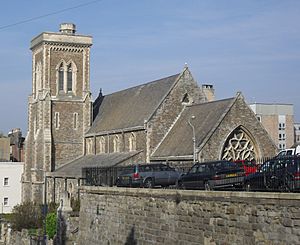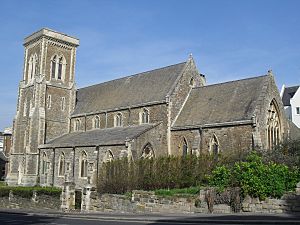St Mary Magdalene's Church, St Leonards-on-Sea facts for kids
Quick facts for kids St Mary Magdalene's Church |
|
|---|---|

The church from the southwest
|
|
| 50°51′12″N 0°33′54″E / 50.8532°N 0.5650°E | |
| Location | St Margaret's Road/Church Road, St Leonards-on-Sea, Hastings, East Sussex TN37 6EE |
| Country | England |
| Denomination | Greek Orthodox |
| History | |
| Status | Church |
| Founded | 1852 |
| Dedication | Mary Magdalene |
| Events | 1982: Sold to Greek Orthodox community 1983: Reopened as Greek Orthodox church |
| Architecture | |
| Functional status | Active |
| Heritage designation | Grade II |
| Designated | 14 September 1976 |
| Architect(s) | Frederick Marrable |
| Style | Decorated Gothic Revival |
| Completed | 1852 |
| Administration | |
| Parish | Hastings and St Leonards |
| Archdiocese | Thyateira and Great Britain |
St Mary Magdalene's Church is a beautiful Greek Orthodox church located in St Leonards-on-Sea, a town by the sea in East Sussex, England. It was built in 1852 and named after Mary Magdalene, one of Jesus' followers.
The church was first built for Anglican worshippers in the new town of St Leonards-on-Sea. This town was planned and started in the 1820s. The church stands high on the skyline, looking over the town. In 1872, a tall tower was added, making it even more noticeable.
In the 1980s, the Anglican community no longer needed the church. It was then bought by the Greek Orthodox Church. They changed it slightly to fit their worship style. However, most of the original parts and its "Gothic" look from the early Victorian era are still there. This church is very important for its history and design. Because of this, English Heritage has given it a special "Grade II" listing.
Contents
A Look Back: The Church's History
How St Leonards-on-Sea Began
Long ago, by the 12th century, Hastings was a very important town in Sussex. The famous Battle of Hastings happened nearby in 1066. Hastings had a castle, made its own money, and was a leader of the Cinque Ports. It even had seven churches!
Around Hastings were large areas of land called manors. One of these was Gensing. It had forests, flat farmland, and a beach. In the early 1800s, Hastings became popular again. People wanted to build new homes and businesses.
A builder named James Burton saw how special the Gensing land was. He bought a big part of it in 1828. He then planned and built a brand new town called St Leonards-on-Sea. This new town grew very quickly. It soon became as popular as Hastings.
Building the First Churches
James Burton built the first Anglican church in St Leonards-on-Sea in 1831. It was called St Leonard's Church and could hold 800 people. After Burton passed away in 1837, the town kept growing. A new train station, St Leonards Warrior Square railway station, opened in 1851. This helped the town expand even more.
St Leonard's Church was in the western part of the town. It was the only Anglican church there. In 1848, a Roman Catholic church opened near Warrior Square. So, in 1850, a group of people decided to build a new Anglican church for the eastern part of St Leonards-on-Sea.
Choosing the Name and Location
The land James Burton bought was part of two old areas: St Leonard's and St Mary Magdalene's. The St Mary Magdalene area, to the east, was named after a medieval hospital. There was no old church with that name. So, the new church was named St Mary Magdalene's.
Charles Eversfield gave the land for the new church. It was a high spot, perfect for a landmark overlooking Warrior Square. Money for the church came from the Bishop of Chichester and others. Frederick Marrable was chosen to design the church.
Work on the church began in 1852. It was built in the Decorated Gothic style. The church opened in the same year and could hold 822 worshippers. It cost a lot of money for the time, about £12,000.
Changes Over Time
The original plans for the church included a tall tower and a spire. The spire was never built, but the tower was added in 1872. It was built at the southwest corner. In the same year, an organ room and a vestry (a room for priests) were added. A new window was also put in the chancel (the area around the altar).
Beautiful Stained glass windows by Morris & Co. were added in 1882. Later, in 1935, a simple brick church hall was built next to the church.
In 1980, the Diocese of Chichester decided the church was no longer needed by the Anglican community. Soon after, the local Greek Orthodox community bought it. This happened around 1981, 1982, or 1983. In 1983, they added an iconostasis, which is a screen covered with religious pictures, as the main feature of the church.
What the Church Looks Like
St Mary Magdalene's Church is a very well-designed church. It uses the "Decorated Gothic Revival" style, which was popular in the mid-1800s. It is a "large and impressive" building on a high corner. This makes it stand out in the town.
Like other churches in the area, it uses a lot of local stone. Both the inside and outside walls are made of sandstone blocks. The design looks like a typical 14th-century church.
The church has a main area called a nave with high windows (a clerestory). It also has aisles on both sides. There is a chancel at a lower level. The church has a strong, four-part tower with a small turret. There is also a porch and a vestry.
The aisles have five sections each and are separated from the nave by arches. The tower is at the end of the south aisle. It has pairs of tall, narrow windows on its top part. The chancel has a special hammerbeam roof in a Perpendicular Gothic style.
Inside, many original features are still there. Some Stained glass windows from the 1800s were damaged in 1943. But some beautiful windows by artists like Edward Burne-Jones and Morris & Co. remain. You can also see a three-seat sedilia (seats for priests) and a piscina (a basin for washing sacred vessels). There is also a reredos (a screen behind the altar) with a carving of the Last Supper. The church also has a special porch and an eight-sided font with carvings.
The Church Today
St Mary Magdalene's Church was given a "Grade II" listing by English Heritage on September 14, 1976. This means it is a "nationally important" building with "special interest." As of February 2001, it was one of many listed buildings in Hastings.
The church is part of the Hastings and St Leonards parish. This parish belongs to the Greek Orthodox Archdiocese of Thyateira and Great Britain. The church has two priests. One of them also serves another Greek Orthodox church in Eastbourne. That church was also once a different kind of church. Similarly, the Greek Orthodox Church of the Holy Trinity, Brighton in Brighton was once an Anglican church before becoming Greek Orthodox in 1985.
The church is officially registered for worship.
See also
- List of places of worship in Hastings
- St. George's Episcopal Memorial Church, a church in the US with a stained glass window containing shards of glass collected from this church when it was damaged in World War II.



